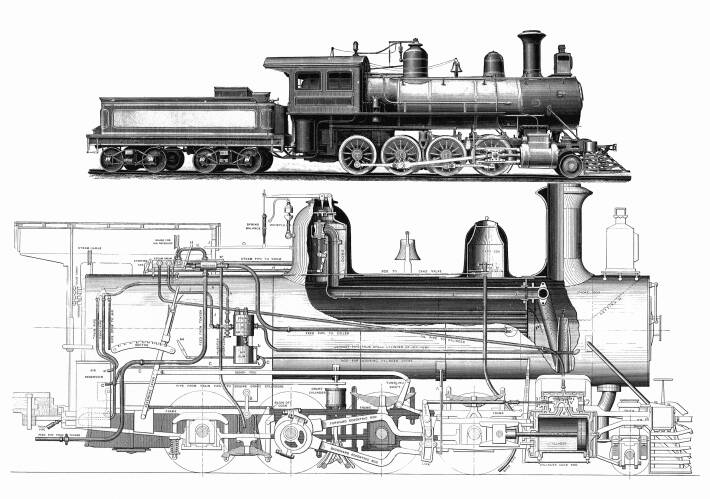|

1887. 2-8-0 CLASS R
IN 1885 the Pennsylvania Railroad designed and built at its
Altoona Shops a new class of Consolidation engine for freight
service. It was so successful that a considerable number were
built both by the company's shops and the Baldwin Locomotive Works
up to the nineties. These were the Class R (new classification
H3) locomotives. They are particularly interesting in that they
had the first Belpaire boilers to be used on Pennsylvania Railroad
motive power.
Cylinders 20 by 24 inches Total weight 114,620 pounds Driving
wheels 50 inches in diameter Weight on drivers 100,590 pounds
Total wheelbase 21 feet 9 inches Rigid wheelbase 13 feet 10 inches
Tractive force 22,850 pounds
The lower section of the illustration shows a cross section
of the same locomotive and gives an idea of its various parts.
The principles of a steam locomotive's operation are, of course,
the same today as always and to the uninitiated perhaps a short
resume of their functions might be interesting.
The illustration does not show the grates or firebox but they
are located above the ash pan. The sides as well as the back of
the firebox have "water spaces" so that as much heating
area as possible is provided. The tubes in the boiler, a few of
which are shown, are for the same purpose. Steam is taken from
the highest point in the steam dome, being controlled by the throttle
valve. From this the steam pipe takes it to the cylinders, the
slide valves in the steam chests above them controlling its admission
into each end alternatively and thus acting on the piston. The
eccentrics shown on the third axle may be set by means of the
reverse lever to control the slide valves, both for forward motion
or reverse. This method has been superseded by the present external
"valve gear" used on more modern engines, but its purpose
was the same.
For supplying water to the boiler, the injector is used. This
forces water into the boiler by means of a steam jet. A steam
cylinder operates the air pump which automatically maintains a
fixed pressure in the air reservoir. This supply of compressed
air is used for the brake system and all the brakes on the train
are simultaneously controlled with the engine brakes. Dry sand
kept in the sandbox is applied to the rails if they are slippery
or to help adhesion when starting.
They Don't Make
'Em | Contents Page
|







